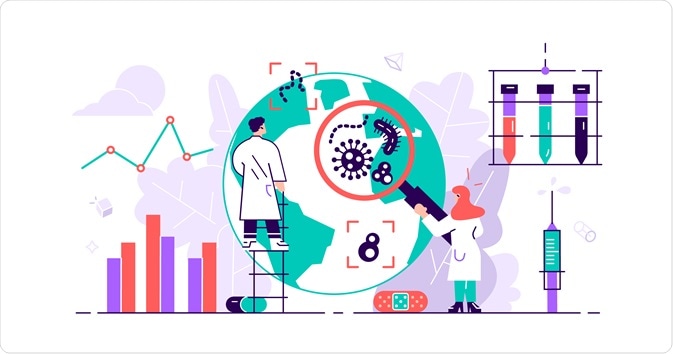
This article discusses the importance of a well-functioning disease surveillance device that could assist lessen the effect of disorder and outbreaks.
Epidemiology is one of the important aspects which need to be addressed for the sheer knowledge of the people. Epidemiology is defined as the scientific, methodical, and data-driven study of the distribution (frequency, pattern) and determinants (causes, risk factors) of health-related states and occurrences (not only illnesses, disease) is defined populations (neighborhood, school, city, state, country, global).
Details
Epidemiology has emerged as a key subject to save you and manipulate infectious illnesses (for non-communicable illnesses as well). The software of concepts of epidemiology is attainable via systematic series and well-timed evaluation and dissemination of records at the illnesses. This is to provoke movement to both save you or prevent the addition spread, a system termed disorder surveillance.

In the late nineteenth century, with the emergence of knowledge that germs reason illnesses, after which withinside the starting of the twentieth century, with the invention of antibiotics and advancement in present-day medicine, interest in epidemiology shifted. First-world nations (big earners) invested in disorder surveillance infrastructure and systems; however, low- and middle-income nations used phlegmatic assets for scientific care.
In the second half of the 20th century, as a part of the worldwide efforts for smallpox eradication, many nations regarded the significance and began to spend money on and toughen the illnesses surveillance gadget. These efforts were boosted further due to the emergence of Avian flu in 1997 and the Severe Acute Respiratory Syndrome (SARS) outbreak in 2002-04.

Surveillance in India
In 1997, India established the National Surveillance Programme for Communicable Diseases. This project, however, remained underdeveloped until 2004, when, in the aftermath of the SARS outbreak, India established the Integrated Disease Surveillance Project (IDSP). The IDSP focused on increasing government financing for disease monitoring, strengthening laboratory capacity, training the health workers, and having at least one qualified epidemiologist in each district of India. When the COVID-19 pandemic occurred, India could quickly deploy teams of epidemiologists and public health professionals to respond to and manage the response, organize contact tracing, and swiftly scale-up testing capacity, thanks to the IDSP (which has now become a full-fledged program).

Issues
The disease surveillance system and the health data collection and reporting systems are important instruments in epidemiology; nevertheless, their performance has varied among Indian states. This is clear from current analyses, whether they are seroprevalence survey results or a study of extra COVID-19 fatalities. Surplus fatalities are also expected to be greater in states with poor disease monitoring systems and civil registration and vital statistics (CRVS) systems. An increase in instances of any ailment would be detected promptly in a well-functioning disease monitoring system.
Forward approach
In 2015, a collaborative monitoring mission reviewed the IDSP and provided a few tangible recommendations to enhance disease surveillance systems. These included increasing financial resource allocation, providing an adequate number of trained human resources, fortifying labs, and increasing monitoring for zoonosis, influenza, and vaccine-preventable diseases.
These proposals must be reconsidered and implemented. At a more specific level, health officials should consider the following. The Union and State governments must enhance government resources devoted to preventative and promotional health services, as well as illness surveillance.  The primary healthcare personnel in both rural and urban regions need to be retrained in disease surveillance and public health activities. Surveillance staff openings at all levels must be filled as soon as possible. The laboratory capacity for COVID-19, which has been built up over the previous 18 months, has to be planned and repurposed to improve the ability to test for additional public health problems and diseases.
The primary healthcare personnel in both rural and urban regions need to be retrained in disease surveillance and public health activities. Surveillance staff openings at all levels must be filled as soon as possible. The laboratory capacity for COVID-19, which has been built up over the previous 18 months, has to be planned and repurposed to improve the ability to test for additional public health problems and diseases.
The idea of ‘One Health’ must be advanced beyond policy discussions and made operational on the ground. Emerging outbreaks of zoonotic illnesses in Uttar Pradesh, such as the Nipah virus, avian flu, and scrub typhus, serve as a reminder of the interdependence of human and animal health. There must be a concerted effort to enhance civil registration and vital statistics (CRVS) systems, as well as medical certification of cause of death (MCCD).
These work in tandem with disease surveillance systems. It is also time for the state government and municipal governments to work together to establish joint action plans and accept responsibility for public health and disease surveillance. The 15th Finance Commission’s allocation to companies for health should be used to kickstart this process.

Conclusion
The development and re-emergence of new and old illnesses, as well as a rise in endemic disease cases, are inescapable. Their influence can be mitigated with a well-functioning illness surveillance system and the application of epidemiological concepts. There is a need for coordinated efforts between a disease monitoring system, a civil registration system, and medical statistics specialists, all guided by epidemiological concepts.




